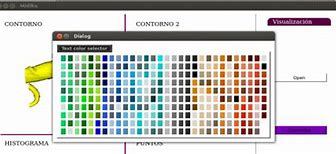
Advanced Host Controller Interface
Advanced Host Controller Interface (AHCI) is an open host controller interface published and used by Intel, which has become a de facto standard. It allows the use of advanced features of SATA such as hotplug and native command queuing (NCQ). If AHCI is not enabled by the motherboard and chipset, SATA controllers typically operate in "IDE[b] emulation" mode, which does not allow access to device features not supported by the ATA (also called IDE) standard.
Windows device drivers that are labeled as SATA are often running in IDE emulation mode unless they explicitly state that they are AHCI mode, in RAID mode, or a mode provided by a proprietary driver and command set that allowed access to SATA's advanced features before AHCI became popular. Modern versions of Microsoft Windows, Mac OS X, FreeBSD, Linux with version 2.6.19 onward,[13] as well as Solaris and OpenSolaris, include support for AHCI, but earlier operating systems such as Windows XP do not. Even in those instances, a proprietary driver may have been created for a specific chipset, such as Intel's.[14]
SATA revisions are typically designated with a dash followed by Roman numerals, e.g. "SATA-III",[15] to avoid confusion with the speed, which is always displayed in Arabic numerals, e.g. "SATA 6 Gbit/s". The speeds given are the raw interface rate in Gbit/s including line code overhead, and the usable data rate in MB/s without overhead.
Backward and forward compatibility
At the hardware interface level, SATA and PATA (Parallel AT Attachment) devices are completely incompatible: they cannot be interconnected without an adapter.
At the application level, SATA devices can be specified to look and act like PATA devices.[83]
Many motherboards offer a "Legacy Mode" option, which makes SATA drives appear to the OS like PATA drives on a standard controller. This Legacy Mode eases OS installation by not requiring that a specific driver be loaded during setup, but sacrifices support for some (vendor specific) features of SATA. Legacy Mode often if not always disables some of the boards' PATA or SATA ports, since the standard PATA controller interface supports only four drives. (Often, which ports are disabled is configurable.)
The common heritage of the ATA command set has enabled the proliferation of low-cost PATA to SATA bridge chips. Bridge chips were widely used on PATA drives (before the completion of native SATA drives) as well in standalone converters. When attached to a PATA drive, a device-side converter allows the PATA drive to function as a SATA drive. Host-side converters allow a motherboard PATA port to connect to a SATA drive.
The market has produced powered enclosures for both PATA and SATA drives that interface to the PC through USB, Firewire or eSATA, with the restrictions noted above. PCI cards with a SATA connector exist that allow SATA drives to connect to legacy systems without SATA connectors.
SATA 1.5 Gbit/s and SATA 3 Gbit/s
The designers of SATA standard as an overall goal aimed for backward and forward compatibility with future revisions of the SATA standard. To prevent interoperability problems that could occur when next generation SATA drives are installed on motherboards with standard legacy SATA 1.5 Gbit/s host controllers, many manufacturers have made it easy to switch those newer drives to the previous standard's mode. Examples of such provisions include:
The "force 150" switch (or equivalent) is also useful for attaching SATA 3 Gbit/s hard drives to SATA controllers on PCI cards, since many of these controllers (such as the Silicon Image chips) run at 3 Gbit/s, even though the PCI bus cannot reach 1.5 Gbit/s speeds. This can cause data corruption in operating systems that do not specifically test for this condition and limit the disk transfer speed.[citation needed]
Kami mohon maaf atas kebingungannya, tetapi kami tidak bisa tahu apakah Anda adalah seseorang atau skrip.
Centang kotak ini dan kami akan berhenti menghalangi Anda.
Komponen Motherboard Berbicara mengenai hardware (perangkat keras), pada sistem komputer pasti akan berkaitan dengan CPU. Dalam komponen CPU terdapat yang namanya “Motherboard” atau “papaninduk”. Motherboard merupakan hardware yang fungsinya sebagai tempat dari berbagai jenis sistem komputer yang saling terhubung. Bisa dibilang, motherboard adalah media untuk menghubungkan perangkat komputer. Bentuk dari motherboard mirip papan seperti nama istilahnya. Membahas mengenai motherboard, ternyata hardware yang satu ini punya beberapa komponen-komponen yang mungkin belum banyak diketahui oleh orang banyak. Komponen-komponen ini tentunya mempunyai fungsi masing-masing. Yuk, simak pembahasannya! Komponen-Komponen Motherboard Berikut ini adalah komponen-komponen dari motherboard yang bisa Anda kenali serta dipelajari fungsinya agar tidak salah dalam memasang atau menggunakannya. 1.Socket Prosessor atau CPU Socket Ilustrasi Socket Prosessor CPU Socket adalah suatu komponen dari motherboard yang digunakan sebagai tempat untuk memasang prosesor. Dari tampilannya pada CPU, komponen yang satu ini memiliki 4 lubang yang berguna untuk penyangga dari Heatsink ...
Computer bus interface for storage devices
SATA (Serial AT Attachment)[a][2] is a computer bus interface that connects host bus adapters to mass storage devices such as hard disk drives, optical drives, and solid-state drives. Serial ATA succeeded the earlier Parallel ATA (PATA) standard to become the predominant interface for storage devices.
Serial ATA industry compatibility specifications originate from the Serial ATA International Organization (SATA-IO) which are then released by the INCITS Technical Committee T13, AT Attachment (INCITS T13).[3]
SATA was announced in 2000[4][5] in order to provide several advantages over the earlier PATA interface such as reduced cable size and cost (seven conductors instead of 40 or 80), native hot swapping, faster data transfer through higher signaling rates, and more efficient transfer through an (optional) I/O queuing protocol. Revision 1.0 of the specification was released in January 2003.[2]
Serial ATA industry compatibility specifications originate from the Serial ATA International Organization (SATA-IO). The SATA-IO group collaboratively creates, reviews, ratifies, and publishes the interoperability specifications, the test cases and plugfests. As with many other industry compatibility standards, the SATA content ownership is transferred to other industry bodies: primarily INCITS T13[3] and an INCITS T10 subcommittee (SCSI), a subgroup of T10 responsible for Serial Attached SCSI (SAS). The remainder of this article strives to use the SATA-IO terminology and specifications.
Before SATA's introduction in 2000, PATA was simply known as ATA. The "AT Attachment" (ATA) name originated after the 1984 release of the IBM Personal Computer AT, more commonly known as the IBM AT.[6] The IBM AT's controller interface became a de facto industry interface for the inclusion of hard disks. "AT" was IBM's abbreviation for "Advanced Technology"; thus, many companies and organizations indicate SATA is an abbreviation of "Serial Advanced Technology Attachment". However, the ATA specifications simply use the name "AT Attachment", to avoid possible trademark issues with IBM.[7]
SATA host adapters and devices communicate via a high-speed serial cable over two pairs of conductors. In contrast, parallel ATA (the redesignation for the legacy ATA specifications) uses a 16-bit wide data bus with many additional support and control signals, all operating at a much lower frequency. To ensure backward compatibility with legacy ATA software and applications, SATA uses the same basic ATA and ATAPI command sets as legacy ATA devices.
The world's first SATA hard disk drive is the Seagate Barracuda SATA V, which was released in Jan 2003.[8]
SATA has replaced parallel ATA in consumer desktop and laptop computers; SATA's market share in the desktop PC market was 99% in 2008.[9] PATA has mostly been replaced by SATA for any use; with PATA in declining use in industrial and embedded applications that use CompactFlash (CF) storage, which was designed around the legacy PATA standard. A 2008 standard, CFast, to replace CompactFlash is based on SATA.[10][11]
The Serial ATA spec requires SATA devices be capable of hot plugging; that is, devices that meet the specification are capable of insertion or removal of a device into or from a backplane connector (combined signal and power) that has power on. After insertion, the device initializes and then operates normally. Depending upon the operating system, the host may also initialize, resulting in a hot swap. The powered host and device do not need to be in an idle state for safe insertion and removal, although unwritten data may be lost when power is removed.
Unlike PATA, both SATA and eSATA support hot plugging by design. However, this feature requires proper support at the host, device (drive), and operating-system levels. In general, SATA devices fulfill the device-side hot-plugging requirements, and most SATA host adapters support this function.[1]
For eSATA, hot plugging is supported in AHCI mode only. IDE mode does not support hot plugging.[12]
SATA revision 2.0 (3 Gbit/s, 300 MB/s, Serial ATA-300)
SATA revision 2.0 was released in April 2004, introducing Native Command Queuing (NCQ). It is backward compatible with SATA 1.5 Gbit/s.[18]
Second-generation SATA interfaces run with a native transfer rate of 3.0 Gbit/s that, when accounted for the 8b/10b encoding scheme, equals to the maximum uncoded transfer rate of 2.4 Gbit/s (300 MB/s). The theoretical burst throughput of the SATA revision 2.0, which is also known as the SATA 3 Gbit/s, doubles the throughput of SATA revision 1.0.
All SATA data cables meeting the SATA spec are rated for 3.0 Gbit/s and handle modern mechanical drives without any loss of sustained and burst data transfer performance. However, high-performance flash-based drives can exceed the SATA 3 Gbit/s transfer rate; this is addressed with the SATA 6 Gbit/s interoperability standard.
Announced in August 2005, SATA revision 2.5 consolidated the specification to a single document.[19][20]
Announced in February 2007, SATA revision 2.6 introduced the following features:[21]
SATA revision 3.0 (6 Gbit/s, 600 MB/s, Serial ATA-600)
Serial ATA International Organization (SATA-IO) presented the draft specification of SATA 6 Gbit/s physical layer in July 2008,[22] and ratified its physical layer specification on August 18, 2008.[23] The full 3.0 standard was released on May 27, 2009.[24]
Third-generation SATA interfaces run with a native transfer rate of 6.0 Gbit/s; taking 8b/10b encoding into account, the maximum uncoded transfer rate is 4.8 Gbit/s (600 MB/s). The theoretical burst throughput of SATA 6.0 Gbit/s is double that of SATA revision 2.0. It is backward compatible with earlier SATA implementations.[22]
The SATA 3.0 specification contains the following changes:
In general, the enhancements are aimed at improving quality of service for video streaming and high-priority interrupts. In addition, the standard continues to support distances up to one meter. The newer speeds may require higher power consumption for supporting chips, though improved process technologies and power management techniques may mitigate this. The later specification can use existing SATA cables and connectors, though it was reported in 2008 that some OEMs were expected to upgrade host connectors for the higher speeds.[25]
Released in July 2011, SATA revision 3.1 introduced or changed the following features:[26][27]
Released in August 2013, SATA revision 3.2 introduced the following features:[32]
Released in February 2016, SATA revision 3.3 introduced the following features:[41][42]
The new Power Disable feature (similar to the SAS Power Disable feature) uses Pin 3 of the SATA power connector. Some legacy power supplies that provide 3.3 V power on Pin 3 would force drives with Power Disable feature to get stuck in a hard reset condition preventing them from spinning up. The problem can usually be eliminated by using a simple “Molex to SATA” power adaptor to supply power to these drives.[44]
Released in June 2018, SATA revision 3.4 introduced the following features that enable monitoring of device conditions and execution of housekeeping tasks, both with minimal impact on performance:[45]
Released in July 2020, SATA revision 3.5 introduces features that enable increased performance benefits and promote greater integration of SATA devices and products with other industry I/O standards:[46]
SATA revision 3.5a was released in March 2021.
SATA 1.5 Gbit/s and SATA 6 Gbit/s
SATA 1.5 Gbit/s and SATA 6 Gbit/s are compatible with each other. Most devices that are only SATA 1.5 Gbit/s can connect with devices that are SATA 6 Gbit/s, and vice versa, though SATA 1.5 Gbit/s devices only connect with SATA 6 Gbit/s devices at the slower 1.5 Gbit/s speed.
SATA 3 Gbit/s and SATA 6 Gbit/s
SATA 3 Gbit/s and SATA 6 Gbit/s are compatible with each other. Most devices that are only SATA 3 Gbit/s can connect with devices that are SATA 6 Gbit/s, and vice versa, though SATA 3 Gbit/s devices connect with SATA 6 Gbit/s devices only at the slower 3 Gbit/s speed.
Comparison with other buses
SCSI-3 devices with SCA-2 connectors are designed for hot swapping. Many server and RAID systems provide hardware support for transparent hot swapping. The designers of the SCSI standard prior to SCA-2 connectors did not target hot swapping, but in practice, most RAID implementations support hot swapping of hard disks.
Alat berbentuk dudukan slot (docking) ini digunakan untuk membaca secara langsung media hardisk (HDD) notebook ukuran 2,5 inci atau hardisk komputer ukuran 3,5 inci untuk tipe konektor serial-ATA (SATA) atau IDE/ATA sehingga dapat dibaca komputer/notebook melalui koneksi data kecepatan tinggi USB 2.0 atau eSATA tanpa menggunakan selubung (case) dan tanpa memasang sekrup. Keistimewaan docking hardisk ini juga dilengkapi pembaca kartu memori, 2 port USB Hub dan tombol One Touch Back-up (OTB Button) memudahkan dalam mem-BackUp data dengan cara yang sangat cepat dan mudah.
Standable and Convenient Design, Support Many Type of Memory Cards, USB v1.1/2.0 Support, SATA I/SATA II HDD Compatible, Support Al All 2.5"/3.5" SATA & 2.5/3.5" IDE Hard Disk at Any Capacity, One Touch Backup Function (on USB Port Only), Plug and Plays and Hot-Swappable, Power/HDD Access LED Indicator.
Note: HTML is not translated!
Comparison to other interfaces
Parallel SCSI uses a more complex bus than SATA, usually resulting in higher manufacturing costs. SCSI buses also allow connection of several drives on one shared channel, whereas SATA allows one drive per channel, unless using a port multiplier. Serial Attached SCSI uses the same physical interconnects as SATA, and most SAS HBAs also support 3 and 6 Gbit/s SATA devices (an HBA requires support for Serial ATA Tunneling Protocol).
SATA 3 Gbit/s theoretically offers a maximum bandwidth of 300 MB/s per device, which is only slightly lower than the rated speed for SCSI Ultra 320 with a maximum of 320 MB/s total for all devices on a bus.[85] SCSI drives provide greater sustained throughput than multiple SATA drives connected via a simple (i.e., command-based) port multiplier because of disconnect-reconnect and aggregating performance.[86] In general, SATA devices link compatibly to SAS enclosures and adapters, whereas SCSI devices cannot be directly connected to a SATA bus.
SCSI, SAS[citation needed], and fibre-channel (FC) drives are more expensive than SATA, so they are used in servers and disk arrays where the better performance justifies the additional cost. Inexpensive ATA and SATA drives evolved in the home-computer market, hence there is a view that they are less reliable. As those two worlds overlapped, the subject of reliability became somewhat controversial. Note that, in general, the failure rate of a disk drive is related to the quality of its heads, platters and supporting manufacturing processes, not to its interface.
Use of serial ATA in the business market increased from 22% in 2006 to 28% in 2008.[9]























